Dirt and Street With the '06 BMW HP-2 - Motorcycle.com
The three most-sold vehicle models on the road today are pickup trucks and SUVs, so it would stand to reason that American motorcyclists would demand a similar motorcycle, one that combines manly, intimidating styling and off-road practicality with a simple, powerful motor that is noisy and pisses off environmentalists. You'd think, but in fact they buy cruisers and sportbikes, machines with as much off-road capability as a microwave oven.
If they change their tune, they might make BMW the largest manufacturer of two-wheeled vehicles in Europe. 25 years ago BMW introduced its landmark R80GS, an air-cooled on and off-road (GS stands for Gelande/Strasse or field/street) two-cylinder motorcycle with big knobby tires and long-travel suspension that could handle prolonged high speeds on the highway as well as be manageable in the unpaved wilderness Germans like to stomp under their Birkenstocks. As the decades rolled under the tires of thousands of GSs in air and oil-cooled versions, the GS series became known as the bike to take on tour when dirt roads -- or no roads -- were on the route.
Like its middle age riders, the GS got more and more portly as BMWs engineers added the features the customers demanded, like telelever suspension, ABS brakes, wide, comfortable passenger seats, fairings, heated grips and alternators big enough to power Wrigley Field for an evening double-header. For 2005, BMW put their R1200GS on a diet, resulting in a bike that is much lighter than its forbearer at a claimed dry weight of 439 pounds, but hardly a 125 motocrosser. We motorcycle journalists use lots of words like "stable", "comfortable" and "smooth" to describe the BMW, but "flickable" and "effortless" have yet to be pulled from our big red rolling toolchest of clichés to describe a Boxer twin.
BMW's F650 family is somewhat lighter and more nimble than the R-GS series. They're fun little bikes, and they come closest to the spirit of those simple, early R80GSs, but with a liquid-cooled single-cylinder motor and chain (or belt) drive, the "Funduro" may be fun, but not really the same thing.
At highway speeds that hard-working little thumper feels buzzy and breathless, and what if you were being chased through a mountain pass by bandits in Colombia with your wife on the back and two saddlebags full of chinchilla pelts? You'd be doomed, but BMW is known as being a slightly stuffy company that makes comfortable, heavy bikes giving you just the performance you need, not the performance you want.
That might have changed a bit last year, when BMW announced the creation of a new "HP" (high performance) line of motorcycles. These would be bikes with a goal of providing a less-compromised dynamic experience. The first model was the HP-2, based loosely on the R1200GS, but with a genuine 45mm inverted front cartridge fork, a rear air shock that looks as if it could land a Trophy Truck, a 1200cc opposed-twin motor making a claimed 105 hp, and a claimed dry weight of just 389 pounds.
Sounds great, doesn't it? However, BMW doesn't seem to like making motorcycles exactly the way people want, and if they do want them, they come with a steep price tag. The HP-2 has a stratospheric 36 inch-high seat, is being made in small quantities, and some of you louts out there might think $19,990 is a lot to pay for a dirtbike, even if it is built to 120% scale. Because of these minuses, we had no plans to test one.
So we were surprised when BMW mentioned that they had a bike available; did we want to test it? 20 minutes later we were down at BMW's fleet center checking out a blue 2006 HP-2. Comic antics ensued as the shortest guy around suited up to ride the Clydesdale of motorcycles back to MO's headquarters. "Are you sure you can ride that thing?" chorused everybody who saw me zipping up my Aerostich.
'...the HP-2s 89 hp makes this a pretty briskly-accelerating weapon'
"Sure", said I, swinging a leg over the bike, "I'll just sort of lean off to one side. There's no bike I can't ride because the seat's too tall!" With that, I tried to hoist the bike off the stand, finding I could barely hold the thing upright. I could just keep it up by standing on tip-toe on one foot, with my body leaned to one side. I will never complain about a tall seat again.
The bike comes to life when you flick the normal-looking ignition key to the on position. The instrument display is simple and unadorned, with a 150 mph speedometer and a Rider Information Display next to it. There's no tachometer. Hitting the starter button results in the motor firing up quickly with the usual mechanical clatter that adds to BMWs distinction. Revving the motor makes nice sounds through the free-flowing high-mount muffler and long airbox snorkel.
Stomping down on the shifter easily slips the six-speed gearbox into first and the clutch has a light pull. I give it a bit too much gas with the handlebars turned, and the bike lurches forwards, the rear Metzler Karoo2 full knobbie slipping slightly on the slick concrete of the fleet center's parking lot. I pretend to not notice and tear off down the driveway.
BMW twins have always had a docile, sensible flavor to me, so I didn't think too much could happen if I tweaked the throttle from low RPMs. Wrong! The front wheel climbed up easily, with good control. With a little more judicious throttle, the HP-2 accelerates briskly and cleanly in any gear, running up to its 7,500 rpm redline without any hiccups, flat spots or glitches. Even Dirty -- a stickler when it comes to fuel injection and a guy who slammed the K1200S for having fuel injection issues -- was impressed by the clean acceleration, noting the HP-2s ability to pull cleanly through multiple runs on the MO dyno.
Combined with that low claimed 433 pound wet weight -- which feels about right, in my opinion, the HP-2s 89 hp (measured on the MO Dynojet dynomometer) makes this a pretty briskly-accelerating weapon. The gearbox is nicely spaced, with smooth operation. Driveline lash is not really that noticeable during street riding, although you can feel the clunking as various gears, wheels and shafts line up under hard acceleration.
For high speeds, the only limits are the knobby tires, which feel vague and bumpy on pavement, high bars and total lack of wind protection. Over 80 mph, the windblast on your chest and arms start to add to that vague front end feel, making the HP-2 not as much fun on the freeway as a more street-oriented bike would be. There's no mount for hard luggage, and the plastic tank will make it harder to use a tank bag. But the seat, despite being higher than an NBA urinal, is fairly wide and comfortable and would be a better choice for all-day riding than many sportbike or standard seats I've experienced.
The wide, opposed cylinders are way down in front of you somewhere, so they aren't much of an issue unless you're lanesplitting. Then you need to give traffic a little wider berth than if you were riding a naked standard or thumper enduro, but you still feel as comfortable as you would on a large sportbike. The motor is far enough forward -- and the wheelbase long enough -- so you'll avoid getting "Beemer scars" on your shins from hitting the big Bing fuel injectors under deceleration.
Riding around city streets is fun until you hit a red light. That smooth, instant power is great for getting in and out of gaps in traffic, and the bike's wide, tapered bars and dirtbike geometry make quick steering an effortless pleasure. The big 305mm front disc with a two-piston caliper and steel-braided brake line has great feel and adequate power, although the knobbies on the front 90/90-21 Karoo2 loose traction before you can loft the back 140/80-17 rear. When you do come to a stop, try to pull up next to a curb or the bumper of a sympathetic-looking motorist so you don't have to hold the bike up on tiptoe while waiting at one of those interminable suburban six-way intersections. I was tempted to just put the kickstand down and stand next to bike while waiting. Maybe the Maven has some nice platform motorcycle boots I can borrow.
A twisty road is another place for pleasure on this punky, muscular boxer. Those of you who read our Ain't the Tool shootout know we at MO are fans of riding dual-sports on pavement, with their supple suspension, upright bars and flexible motors. The Kawasaki KLR650 is a favorite of ours, and the HP-2 felt like the world's most expensive KLR, with its sophisticated, well-damped suspension, very good brakes, stiff chassis, and smooth, powerful motor. It costs what four KLRs cost, but it also feels like it's worth about four KLRs.
The smooth motor is surprising, given how much it's been altered from the standard R1200GS motor. The BMW engineers took great pains to lighten and modify almost every component in the engine, removing the counterbalancer and lightening the flywheel for quick-revving and higher power output. To cope with the extra verve, the Paralever driveshaft and six-speed transmission were beefed up. The result is a powerful motor that is very responsive and flexible, yet doesn't feel particularly intrusive or buzzy.
Another novel feature is the rear air suspension. I always viewed air-adjustable suspensions as non-functional gimmickry, but the EVO unit on the HP-2, jointly developed by Continental Automotive Systems and BMW, works. The rear end absorbed the bumps as well as a spring-equipped one could, without overheating or feeling mushy. It also has an added plus of easy adjustability; a small bicycle pump is clipped to the frame for your convenience.
Dirty Gets the HP-2 Dirtier
Gabe doesn't have much dirt experience, not to mention the fact that he's about 3'6" tall, so the idea of him riding this $20K Paul Bunyan sized beast on a motocross track made us all a bit nervous. On the other hand, though he doesn't claim to be much of a motocrosser, Sean's large size and innate ability to go fast without crashing (knock on wood) made him the logical victim for this test.
Sean: Man, this thing is tall with a capital T! I'm not one to whinge about seat heights, but this is crazy. Unloading the HP-2 from the MO Van requires a step ladder and a prayer.
Spelunking around Elsinore's paddock area, the HP-2 feels like two of your typical MX bikes. 430Lbs and 90hp = 2x CRF 250s. The BMW is geared mighty-tall for a dirt bike, not to mention the fact that it has brakes strong enough to work at freeway speeds on pavement. This means a judicious hand is required on the throttle and on the front brake lever, lest you find yourself sling-shot through your neighbor's pit stall, or dropping the bike with a locked front tire.
The BMW's strong brakes coupled with a vague front end mean I'm destined to spend a good portion of the day sliding the front into berms or changing my shorts in the pits. However, its excellent air shock means the back of the bike was well behaved and steering was easily controlled with the throttle. This really shouldn't be a surprise; how else would you turn a 90hp dirt bike?
By far the biggest surprise of the day was provided by the big BMW's ability to jump and more importantly to land like a motocross bike. Most of this credit goes to the awesome Continental air shock. However, the front suspension was quick to bottom when landing flat or nose-low and would probably benefit from a higher spring rate.
Though it was a bit intimidating, I had a great time aboard the HP-2. It generated a lot of looks at the track and surprised several riders as it blasted past them throwing 90hp worth of roost. As an added bonus, it was the only bike there that could have been ridden home at the end of the day.
I didn't have a chance to ride the HP-2 in the dirt or on a dirt road (see sidebar), but I imagine it would shine there, as it's designed for hard-core off-road use. But that doesn't take away from the bike's user-friendliness and fun on pavement. I quiver with excitement and anticipation when I think of how great this motorcycle would be set up as a supermotard, with sticky 17" tires and a little less suspension travel. Reducing the bike's height and center of gravity would make it a real terror around town and on backroads. Keep it simple, keep the price around what KTM will charge for their big Motard ($12,998) and watch them go out the door.
A light, simple bike true to BMW's roots would bring a lot of old owners back in the fold, as well as attract the hip youngsters BMW so desperately want to court. Build it, BMW, and they will come.
| ** Specifications Courtesy of BMW ** BMW HP 2 Enduro - MSRP: $19,990 | |
| Engine | |
| Engine Type | Air-cooled / oil-cooled Boxer twin-cylinder |
| Displacement | 1170 cc |
| Bore X Stroke | 101.0 mm x 73.0 mm |
| *Claimed* Horsepower | 105 bhp @ 7000 rpm |
| *Claimed* Torque | 85 lb/ft @ 5,500 rpm |
| Valve Gear | Chain-driven, high cam, OHV, w/adj. rocker arms |
| No. of cylinders | 2 |
| Compression Ratio | 11.0 : 1 |
| Engine Management | BMW Engine Controller - BMS K |
| Valves per Cylinder | Four |
| Valves | 2 x 36 mm intake / 2 x 31 mm exhaust |
| Fuel Tank | HDPE, internal pump and internal filter |
| Alternator W | 600 Watts @ 14 Volts |
| Battery V/AH | 12 Volts 12 Amps/hour |
| Engine Summary | The two cylinder flat twin Boxer engine is BMW's famous, time-tested, signature design. First designed in 1923, its two horizontally mounted cylinders are like a boxer's gloves punching each other as he enters the ring. The result is a supremely reliable, flexible engine with a low center of gravity and like all twins, excellent torque characteristics. The exposed cylinders offer excellent air cooling and if it's durability, performance, and bulletproof all-around handling you want, this is your powerplant. |
| Drivetrain | |
| Clutch | 180 mm dry, single plate with hydraulic actuation |
| Gear Box | 6 Speed Gear Box |
| Primary Transmission | 1:1.823 |
| Gear Ratios | I: 2.28:1 II: 1.58:1 III: 1.26:1 IV: 1.03:1 V: 0.90:1 VI: 0.81:1 |
| Final Drive System | Enclosed driveshaft with two universal joints |
| Final Drive Ratio | 2.82:1 |
| Frame & Suspension | |
| Frame | Tubular steel trellis frame |
| Front wheel suspension | WAD UPSD fork 45 mm |
| Rear wheel suspension | BMW EVO Paralever |
| Spring Travel front/rear | 10.6 inches/9.8 inches |
| Ground Clearance | 12.6 inches |
| Handlebar center point angle | 60.5 degrees |
| Brakes | |
| Brake System | Front single disc |
| Front Brakes | One, two-piston caliper |
| Front Rotor | 12.0 inch floating rotors |
| Rear Brakes | Single, two-piston floating caliper |
| Rear Rotor | 10.4 inch single, fixed rotor |
| Actuation | Hydraulic, DOT 4 fluid type |
| Wheels & Tires | |
| Front Wheel | 1.85 x 21 cross spoke |
| Rear Wheel | 2.5 x 17 cross spoke |
| Front Tire | 90/90 x 21 tubeless Continental TKC 80 90/90-21M/C 54Q M+S TL Metzeler Karoo 2 (T) Front 90/90-21 M/C 54Q M+S TL Metzeler Enduro 3 90/90-21 M/C 54H TL |
| Rear Tire | 140/80 x 17 tubeless Continental TKC 80 140/80-17 69Q M+S TL Metzeler Karoo 2 (T) 140/80-17 M/C 69Q M+S TL Metzeler Enduro 3 140/80-17 M/C 69H TL |
| Dimensions | |
| Overall Length | 92.5 inches |
| Overall Width | 34.6 inches |
| Wheelbase | 63.4 inches |
| Seat height | 36.2 inches |
| *Claimed* Weight, unladen, with full tank | 433 lbs |
| Max permissible weight | 838 lbs |
| Fuel Capacity | 2.9 U.S. gallons ; including 1.0 gallon reserve |
More by Gabe Ets-Hokin, Sean Alexander



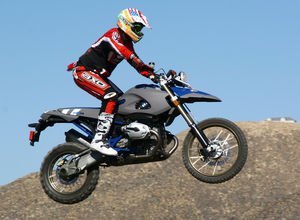













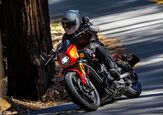
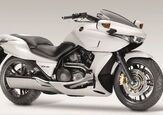
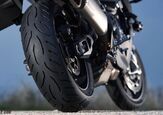
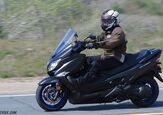
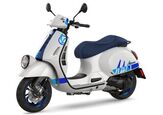
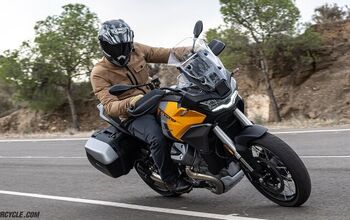
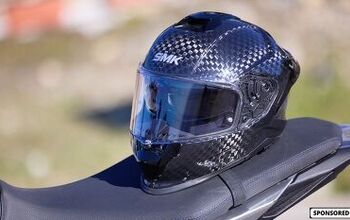
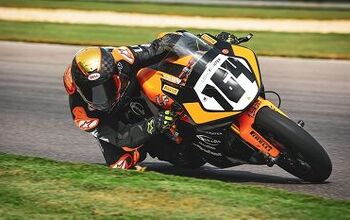
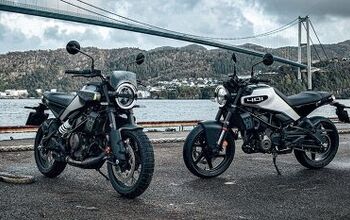
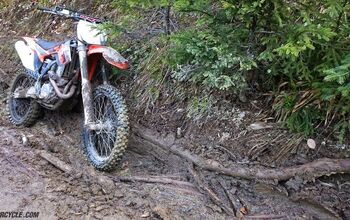
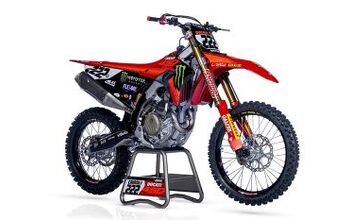
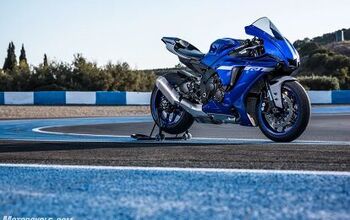
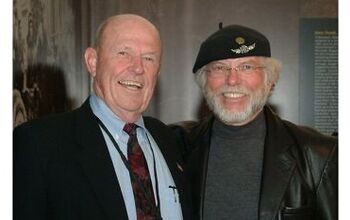
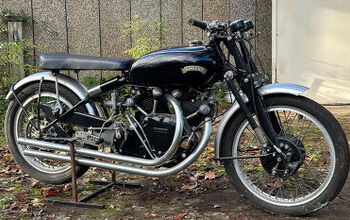
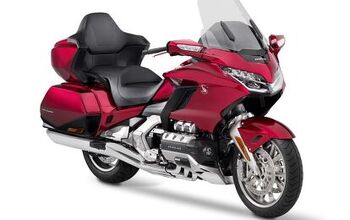
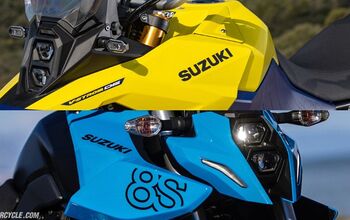
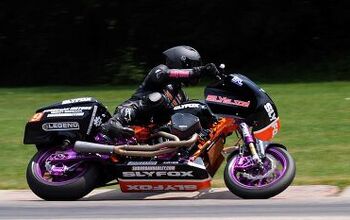
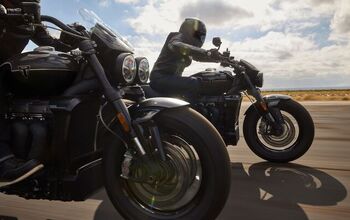
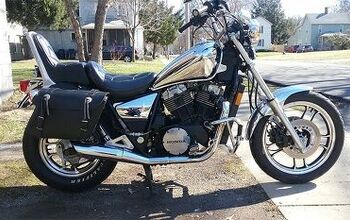
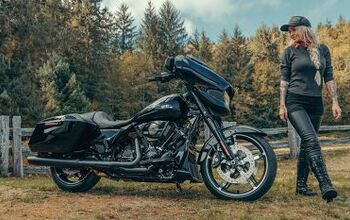
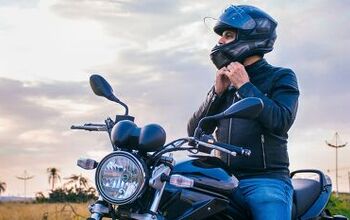
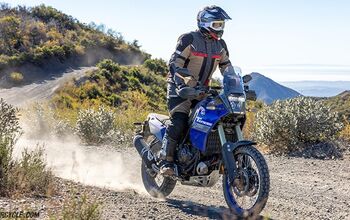

Comments
Join the conversation